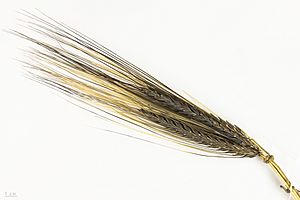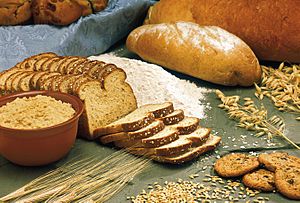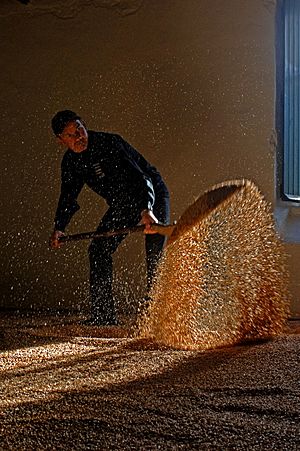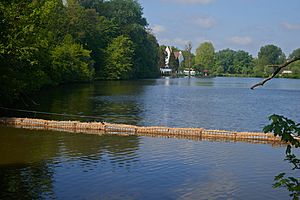Barley facts for kids
Quick facts for kids Barley |
|
|---|---|
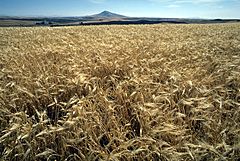 |
|
| Barley field | |
| Scientific classification | |
| Kingdom: | |
| Division: | |
| Class: | |
| Order: | |
| Family: | |
| Genus: |
Hordeum
|
| Species: |
H. vulgare
|
| Binomial name | |
| Hordeum vulgare |
|
Barley is a type of plant. Its seeds are a cereal grain. It is eaten by humans and other animals, and it is one of mankind's oldest crops. It can be made into flour or beer.
Its Latin name is Hordeum vulgare. Barley is an annual plant.
Contents
History
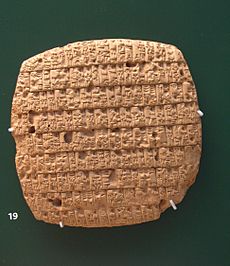
Barley was one of the first domesticated grains in the Fertile Crescent, an area of relatively abundant water in Western Asia, and near the Nile river of northeast Africa. The grain appeared in the same time as einkorn and emmer wheat. Wild barley (H. vulgare ssp. spontaneum) ranges from North Africa and Crete in the west, to Tibet in the east.
Barley (known as Yava in both Vedic and Classical Sanskrit) is mentioned many times in Rigveda and other Indian scriptures as one of the principal grain in ancient India. Traces of Barley cultivation have also been found in post-Neolithic Bronze Age Harappan civilization 5700–3300 years before present.
In the Pulitzer Prize-winning book Guns, Germs, and Steel, Jared Diamond proposed that the availability of barley, along with other domesticable crops and animals, in southwestern Eurasia significantly contributed to the broad historical patterns that human history has followed over approximately the last 13,000 years; i.e., why Eurasian civilizations, as a whole, have survived and conquered others.
Barley beer was probably one of the first alcoholic drinks developed by Neolithic humans. Barley later on was used as currency. Alongside emmer wheat, barley was a staple cereal of ancient Egypt, where it was used to make bread and beer.
Rations of barley for workers appear in Linear B tablets in Mycenaean contexts at Knossos and at Micenaean Pylos.
Barley was a special food of gladiators known as hordearii, "barley-eaters". However, by Roman times wheat had replaced barley as a staple.
Tibetan barley has been a staple food in Tibetan cuisine since the fifth century CE. This grain, along with a cool climate that permitted storage, produced a civilization that was able to raise great armies. The flour is roasted and mixed with butter and butter tea to form a stiff dough that is eaten in small balls.
In medieval Europe, bread made from barley and rye was peasant food, while wheat products were consumed by the upper classes. Potatoes largely replaced barley in Eastern Europe in the 19th century.
Production
| Major barley producers in 2014 | |
|---|---|
| Country | Production (millions of tonnes) |
|
|
|
|
|
|
|
|
|
|
|
|
|
|
|
|
|
|
|
|
|
|
|
|
|
|
|
|
|
|
In 2014, world production of barley was 144 million tonnes, with the Russian Federation producing 14% of this total, followed by France and Germany as the top producers (table).
Cultivation
Barley is a widely adaptable crop. It is currently popular in temperate areas where it is grown as a summer crop and tropical areas where it is sown as a winter crop. Its germination time is one to three days. Barley grows under cool conditions, but is not particularly winter hardy.
Barley is more tolerant of soil salinity than wheat, which might explain the increase of barley cultivation in Mesopotamia from the second millennium BCE onwards. Barley is not as cold tolerant as the winter wheats (Triticum aestivum), fall rye (Secale cereale) or winter triticale (× Triticosecale Wittm. ex A. Camus.), but may be sown as a winter crop in warmer areas of Australia and Great Britain.
Barley has a short growing season and is also relatively drought tolerant.
Plant diseases
This plant is known or likely to be susceptible to barley mild mosaic bymovirus, as well as bacterial blight. It can be susceptible to many diseases, but plant breeders have been working hard to incorporate resistance.
Food
Nutrition
In a 100 gram serving, raw barley provides 352 calories and is a rich source (20% or more of the Daily Value, DV) of essential nutrients, including protein, dietary fiber, the B vitamins, niacin (31% DV) and vitamin B6 (20% DV), and several dietary minerals (table). Highest nutrient contents are for manganese (63% DV) and phosphorus (32% DV) (table). Raw barley is 78% carbohydrates, 1% fat, 10% protein and 10% water (table).
Preparation
Hulled barley (or covered barley) is eaten after removing the inedible, fibrous, outer hull. Once removed, it is called dehulled barley (or pot barley or scotch barley). Considered a whole grain, dehulled barley still has its bran and germ, making it a nutritious and popular health food. Pearl barley (or pearled barley) is dehulled barley which has been steam processed further to remove the bran. It may be polished, a process known as "pearling". Dehulled or pearl barley may be processed into a variety of barley products, including flour, flakes similar to oatmeal, and grits.
Barley meal, a wholemeal barley flour lighter than wheat meal but darker in colour, is used in porridge and gruel in Scotland. Barley meal gruel is known as sawiq in the Arab world. With a long history of cultivation in the Middle East, barley is used in a wide range of traditional Arabic, Assyrian, Israelite, Kurdish, and Persian foodstuffs including kashkak, kashk and murri. Barley soup is traditionally eaten during Ramadan in Saudi Arabia. Cholent or hamin (in Hebrew) is a traditional Jewish stew often eaten on Sabbath, in a variety of recipes by both Mizrachi and Ashkenazi Jews, with barley cited throughout the Hebrew Bible in multiple references. In Eastern and Central Europe, barley is also used in soups and stews such as ričet. In Africa, where it is a traditional food plant, it has the potential to improve nutrition, boost food security, foster rural development and support sustainable landcare.
The six-row variety bere is cultivated in Orkney, Shetland, Caithness and the Western Isles in the Scottish Highlands and islands. When milled into beremeal it is used locally in bread, biscuits, and the traditional beremeal bannock.
Health implications
According to Health Canada and the US FDA, consuming at least 3 grams per day of barley beta-glucan or 0.75 grams per serving of soluble fiber can lower levels of blood cholesterol, a risk factor for cardiovascular diseases.
Eating whole-grain barley, as well as other grains with lots of fiber, improves regulation of blood sugar (i.e. reduce blood glucose response to a meal). Consuming breakfast cereals containing barley over weeks to months also improved cholesterol levels and glucose regulation.
Like wheat, rye, and their hybrids and derivatives, barley contains gluten, which makes it an unsuitable grain for consumption by people with gluten-related disorders, such as celiac disease, non-celiac gluten sensitivity and wheat allergy sufferers, among others. Nevertheless, some wheat allergy patients can tolerate barley or rye.
Beverages
Alcoholic beverages
Barley is a key ingredient in beer and whisky production. Two-row barley is traditionally used in German and English beers. Six-row barley was traditionally used in US beers, but both varieties are in common usage now. Distilled from green beer, whiskey has been made primarily from barley in Ireland and Scotland, while other countries have used more diverse sources of alcohol, such as the more common corn, rye and wheat in the USA. In the US, a grain type may be identified on a whisky label if that type of grain constitutes 51% or more of the ingredients and certain other conditions are satisfied. About 25% of the United States' production of barley is used for malting, for which barley is the best-suited grain.
Barley wine is a style of strong beer from the English brewing tradition. Another alcoholic drink known by the same name, enjoyed in the 18th century, was prepared by boiling barley in water, then mixing the barley water with white wine and other ingredients, such as borage, lemon and sugar. In the 19th century, a different barley wine was made prepared from recipes of ancient Greek origin.
Nonalcoholic beverages
Nonalcoholic drinks such as barley water have been made by boiling barley in water. In Italy, barley is also sometimes used as coffee substitute, caffè d'orzo (coffee of barley). This drink is obtained from ground, roasted barley and it is prepared as an espresso (it can be prepared using percolators, filter machines or cafetieres). It became widely used during the Fascist period and WWII, as Italy was affected by embargo and struggled to import coffee. It was also a cheaper option for poor families (often grown and roasted at home) in the period. Afterwards, it was promoted and sold as a coffee substitute for children. Nowadays, it is experiencing a revival and it can be considered some Italians' favourite alternative to coffee when, for health reasons, caffeine drinks are not recommended.
Other uses
Animal feed
Half of the United States' barley production is used as livestock feed. Barley is an important feed grain in many areas of the world not typically suited for maize production, especially in northern climates—for example, northern and eastern Europe. Barley is the principal feed grain in Canada, Europe, and in the northern United States. A finishing diet of barley is one of the defining characteristics of western Canadian beef used in marketing campaigns.
As of 2014, an enzymatic process can be used to make a high-protein fish feed from barley, which is suitable for carnivorous fish such as trout and salmon.
Algicide
Barley straw, in England, is placed in mesh bags and floated in fish ponds or water gardens to help reduce algal growth without harming pond plants and animals. Barley straw has not been approved by the EPA for use as a pesticide and its effectiveness as an algicide in ponds has produced mixed results during university testing in the US and the UK.
Measurement
Barley grains were used for measurement in England, there being three or four barleycorns to the inch and four or five poppy seeds to the barleycorn. This unit still persists in the shoe sizes used in Britain and the USA.
As modern studies show, the actual length of a kernel of barley varies from as short as 4–7 mm (0.16–0.28 in) to as long as 12–15 mm (0.47–0.59 in) depending on the cultivar. Older sources claimed the average length of a grain of barley being 0.345 in (8.8 mm).
The barleycorn was known as arpa in Turkish, and the feudal system in Ottoman Empire employed the term arpalik, or "barley-money", to refer to a second allowance made to officials to offset the costs of fodder for their horses.
Ornamental
A new stabilized variegated variety of Hordeum vulgare, billed as Hordeum vulgare varigate, has been introduced for cultivation as an ornamental and pot plant for pet cats to nibble.
Cultural
The Islamic prophet Muhammad prescribed barley (talbina) for seven diseases. It was also said to soothe and calm the bowels. Avicenna, in his 11th century work The Canon of Medicine, wrote of the healing effects of barley water, soup and broth for fevers. Additionally, barley can be roasted and turned into roasted barley tea, a popular Asian drink.
In English folklore, the figure of John Barleycorn in the folksong of the same name is a personification of barley, and of the alcoholic beverages made from it, beer and whisky. In the song, John Barleycorn is represented as suffering attacks, death, and indignities that correspond to the various stages of barley cultivation, such as reaping and malting. He may be related to older pagan gods, such as Mímir or Kvasir.
Images for kids
See also
 In Spanish: Hordeum vulgare para niños
In Spanish: Hordeum vulgare para niños


